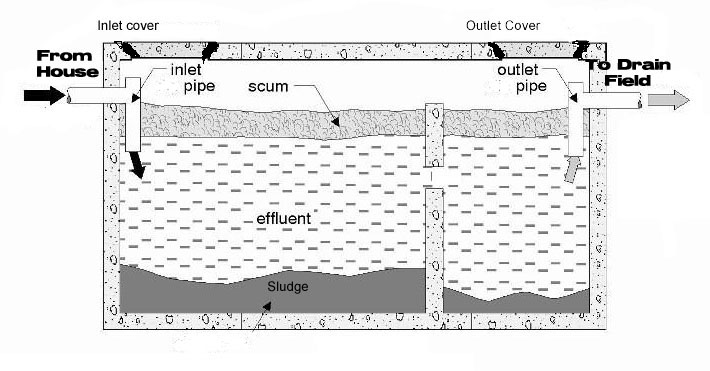What is a septic tank or what is a septic system?
A septic tank is a large holding tank where human waste can decompose into recyclable water or effluent and can be returned to nature. The environmentally dangerous parts can be pumped away and carted off by a truck with a huge vacuum cleaning device, and hauled away to be properly disposed of. Septic tanks have poisonous gasses and should never be entered.
The septic system is comprised of two parts: the tank, and the drain field or leach field. The waste water runs from the house into the tank, there it separates naturally into a scum layer which is floating on top and a sludge layer of heavier materials which sinks to the bottom. Gases will eventually vent into the atmosphere as part of the septic tank’s plumbing system. The tank holds the solids to prevent them from leaching into the surrounding environment and allows the first stage of the bacterial process. Between the sludge and the scum is the relatively clear water (effluent) which is filtered to the distribution box or header pipe and ultimately to the drain field or leach bed which is an area of ground around the tank that can absorb the liquid. Problems occur when there is a blockage in the septic tank or the drain field becomes saturated and can no longer absorb the water or effluent.
1. Question: How do I know if my septic is full?
A: Septic tanks are designed to be filled to the bottom of the outlet baffle, then water exits the tank into the drain field every time water enters the tank from the house.
2. Q: What are some warning signs my septic needs servicing?
A: Toilets that are slow to flush, don’t flush, or septic water backing upon low lying plumbing areas.
3. Q: Where do they take that “stuff?”
A: I have made many jokes about this, but the truth is…. The septage is taken to a local sewer plant where it is treated, the water is used for irrigation, IQ water. The solids as sent to a local fertilizer plant, pasteurized and used for fertilizer.
4. Q: What about adding bacteria like “RID-X?”
A: Adding bacteria never hurts, some tanks perform well without any bacteria. Others, new ones or ones that have a lot of solids may benefit from adding bacteria.
5. Q: Is adding bacteria enough?
A: Nothing takes the place of pumping your septic tank on a regular basis. Every 2-3 maybe 5 years for a larger tank or just one or two people on a single septic tank.
6. Q: I just pumped my tank, why is it “full” again.
A: Sometimes the drain field does not take water, effluent as we call it, for several reasons.
1. Over use, more water is being put into the drain field than it can absorb. a 300 Sq. Ft. drain field can absorb 300 gallons of water per day. More water and the drain field gets saturated, hydraulic overload we call it. Each person uses about 75 gallons per day of water, the more people the more water your septic system has to process.
2. There may be a filter on the outlet side preventing it from reaching the drain field. Filters are designed to keep solids from entering the drain field but become clogged and stop the effluent from leaving the septic tank.
3. Outlet pipes from the tank to the drain field often collapse or get clogged with roots preventing the flow of effluent from the tank to the drain field.
For further Questions Call: 5617471700 or Visit us at: Dan’s Backhoe Service Inc.

